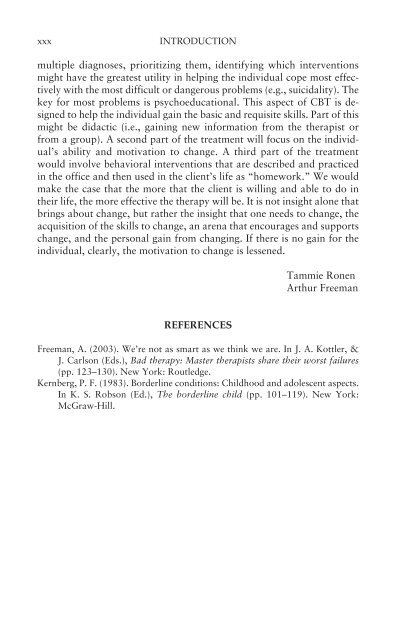Tammie Ronen, PhD - Springer Publishing
Tammie Ronen, PhD - Springer Publishing
Tammie Ronen, PhD - Springer Publishing
Create successful ePaper yourself
Turn your PDF publications into a flip-book with our unique Google optimized e-Paper software.
xvi<br />
FOREWORD<br />
training and exposure), cocaine abuse, opiate dependence, schizophrenia<br />
(CBT is effective for treating delusions), geriatric depression, major depression,<br />
anger, binge-eating disorder, bulimia, anorexia, cancer pain,<br />
chronic pain (CBT, in combination with physical therapy, is effective for<br />
chronic pain in many medical conditions), chronic back pain, sickle cell<br />
disease pain (CBT that has multiple treatment components is effective),<br />
idiopathic pain, somatoform disorders, hypochondriasis, irritable-bowel<br />
syndrome, obesity (CBT is effective in combination with hypnosis), rheumatic<br />
disease pain (CBT that has multiple treatment components), smoking<br />
cessation (group CBT is effective, as well as CBT that has multiple<br />
treatment components, in combination with relapse prevention), marital<br />
discord, erectile dysfunction (CBT is effective for reducing sexual anxiety<br />
and improving communication), disorders concerning extreme dissatisfaction<br />
with body image, atypical sexual practices, sex offenders, geriatric<br />
sleep disorders, withdrawal from antianxiety medications, and bipolar<br />
disorder (CBT is effective for medication adherence).<br />
CBT has been clinically demonstrated to be an effective treatment for<br />
children and adolescents for the following disorders and problems: anxiety<br />
disorders (separation anxiety, avoidant disorder, overanxious disorder),<br />
chronic pain, conduct disorder and oppositional defiant disorder,<br />
depression, adolescent unipolar depression, distress due to medical procedures<br />
(mainly for cancer), phobias, and recurrent abdominal pain. This<br />
is an enormous list of treatment applications, and one that I could not<br />
have envisioned in the early days.<br />
Similarly, the therapeutic techniques of CT have become far more sophisticated<br />
as we have studied what has worked and what has been less<br />
successful in our treatments. I have seen CT grow from our early outpatient<br />
work at the Center for Cognitive Therapy, which was an outpatient<br />
facility that was part of the Department of Psychiatry at the University of<br />
Pennsylvania. The contemporary CT model, adapted from this early<br />
work, has been effectively applied to inpatient work in hospitals, applications<br />
for use in schools and other institutions, and residential, inpatient,<br />
and outpatient settings.<br />
From our early work in treating adults and adult disorders, CT has<br />
been extended to the treatment of children, adolescents, elders, couples,<br />
families, and groups. Finally, I have seen CT extended from our early<br />
work in Philadelphia to be a truly international movement, with cognitive<br />
therapists now to be found around the globe. The International Association<br />
for Cognitive Psychotherapy (IACP) coordinates and sponsors international<br />
conferences on a triennial basis. In June of 2005, as part of the<br />
IACP congress in Gothenburg, Sweden, I had the honor and privilege of<br />
having a public discussion with His Holiness, the Dalai Lama. All of these

















